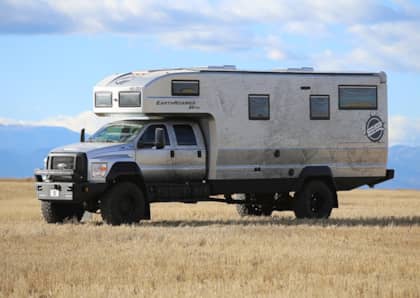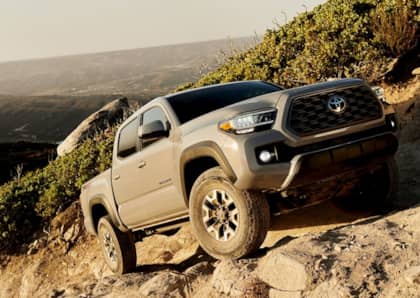Bertone Freeclimber Was BMW's First SUV, by way of Japan
On the automotive island of misfit toys, the rebadged truck holds a special place of honor. Whether it's Honda selling virtually undisguised Land Rovers in its home market, or Isuzu lending out the Rodeo to nearly every automaker on the planet with an SUV-sized hole in its line-up, you could always count on at least one or two ringers with each crop of sport-utilities throughout the 90s and early 2000s.
Sometimes, however, the cross-pollination goes beyond merely swapping the name on the hood or the tailgate. This kind of trans-oceanic corporate synergy is when things really start to get weird, with engines flying in from one factory, bodies from another, and somewhere in the middle is the hope for the engineering genius required to make it all work together in one cohesive package.

It's efforts like this that bear unusual fruit like the Bertone Freeclimber—a truck that combines Italian styling, Japanese design, and German engineering in a tight little off-road package that few people have ever heard of.
Small, But Useful
Daihatsu had longer been known outside the U.S. for building small but rugged SUVs aimed at the off-road crowd. In fact, wheelin' had become a specialty for the Japanese automaker, alongside its sizeable kei crowd line-up, when it introduced the Rugger (also known as the Rocky and the Fourtrak) in 1984 as a replacement for the aging TAFT.
The Rugger was a versatile platform, and while it was exclusively offered as a two-door truck, it could be had in both short and long-wheelbase versions, with the latter stretched out by more than a foot to give rear seat riders a bit of extra breathing room. In terms of body styles, soft tops and hardtops were available, as was a tall-roofed, long-wheelbase wagon.
Chimaera
Towards the end of its lifespan, the Rugger's configurability caught the eye of design house Bertone. Although still enjoying a strong reputation on the world stage, financially things were shaky for the company, and it was actively seeking out inexpensive but unique projects that it could use to fill the coffers with cash.
A deal was struck, and the genesis of the Freeclimber was set in motion. Bertone gave the Rugger a different visual attitude, swapping in a new front end that installed a rounded four-headlight package as compared to the square units on the original vehicle, and then hiding them behind an integrated brush guard. A unique grille was also installed on the Freeclimber, and the entire setup rode on O.Z. wheels.

The real meat of the model were the changes that were impossible to see from the outside. Hand-stitched leather lined the cabin, the options sheet was expanded dramatically from the more spartan list of gear found on the Rugger. Bertone did most of the assembly on the vehicle, too, which included the other invisible upgrade: a slew of BMW engines under the hood.
Big Six Power
Although baptized as a 'Bertone' on the VIN plate, the Freeclimber actually had three parents, with the German luxury brand stepping in to offer the motivation for the model. Altogether, the SUV could be ordered with a trio of power plants: a 2.0-liter straight-six, a larger 2.7-liter version of the same, or a 2.4-liter, straight-six turbodiesel. Each of these engines were lifted directly from BMW's existing showroom, with the big six featured prominently in the 528 sedan.

Power was modest —under 200 horses for all models, with the diesel clocking in at 114 ponies - but still an improvement in terms of performance over the Toyota-sourced engines found in the original Daihatsu. Low-range four-wheel drive was also maintained, as was the availability of a five-speed manual gearbox.
Premium Price
As might be expected, the Bertone Freeclimber was not an inexpensive vehicle. Price-wise it hovered very close to the ask of a Land Rover Range Rover when it was introduced as a 1990 model. Despite the BMW badge found on some models, you couldn't walk into the Bavarian brand's showroom and order one, either. Instead, the Freeclimber was marketed through a variety of European importers and dealers, with Daihatsu itself handling some of the distribution.

Just under 2,800 examples of the Bertone were sold from 1989 to 1992, a small, but profitable run that coincided with Daihatsu retiring the first-generation Rugger. When the second-gen trucklet came out, the Italians were right back in the game with a new version of the Freeclimber, although a 1.6-liter four-cylinder BMW engine was now the only available drivetrain. Another three years would equal nearly the same number of Freeclimber II's sold.
A Lasting, If Obscure, Legacy
Bertone would end production of the Freeclimber in 1995 once a much larger contract from Fiat and Opel came down the pipe, requiring it to shake loose some production capacity for the more profitable project. Still, the little truck stands as the very first SUV to have been built using BMW components while wearing the blue-and-white roundel. Although a far cry from the X5 (which would debut a couple of years later), it did provide the German marque with its first taste of the people-mover business—in addition to serving as a vital economic lifeline for one of the most prestigious design houses on the continent.
If you love 2-door SUVs, take a peek at The Six Best and Five Weirdest SUVs of all time.










